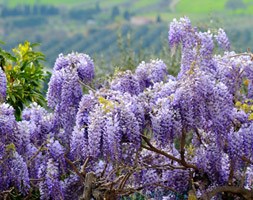Wisteria
by Diane - May 9th, 2014.Filed under: Crocus.
A wonderful plant when growing up the front of an old house. Stunning colour in summer.

Wisteria sinensis ‘Amethyst’ (Chinese wisteria) £24.99
Position: full sun or light, dappled shade Soil: fertile, moist, well-drained soil Rate of growth: fast-growing Flowering period: May to June Flower colour: violet-blue with a reddish flush Other features: velvety, green seed-pods in hot summers; all parts of the plant are harmful if ingested Hardiness: fully hardy Magnificent clusters of well-scented, red-flushed, violet-blue flowers appear on this vigorous twining climber from late spring to early summer. The foliage emerges soon after the flowers, and often has an initial bronze flush, which fades as the leaves mature. If possible place it near a seating area or walkway, so you can fully appreciate the fragrant blooms, and provide a sturdy support for it to climb over. Garden care: To get lots of flowers, the twining stems need pruning twice a year – once in summer (about two months after the flowering has finished) and again in mid-winter. To train your Wisteria against a wall, the wall will first need a network of stout horizontal wires, attached at approximately 30cm intervals. After planting, prune the leading shoot of your Wisteria back to approximately 90cm above ground level and remove any side branches as this will encourage a strong new leader to form. In the summer of the first growing season, tie the leader in vertically and choose two new lateral shoots on either side of the leader. Tie these onto the wires at a 45 degree angle. Any smaller shoots coming from these lateral branches should be cut back to two or three buds. In the first winter, cut back the leader to a bud approximately 75cm above the highest lateral branch. Gently untie the lateral branches and prune them back by about a third, then re-tie them onto a wire so they are nearly horizontal. In subsequent summers (and until the plant has filled the allotted space), tie in the leader as it grows and choose two strong laterals to form the next tier. These should then be tied in at a 45 degree angle and as in the previous year, any smaller shoots coming from these should be cut back to two or three buds. In subsequent winters cut back the leading shoot as before and cut back and re-tie the new laterals to a near-horizontal position. The older laterals can be cut back by about a third of their total length. Once the plant has become established and reached the desired height, keep tying in the lateral stems as they spread out. In summer, cut back the wispy stems on both the laterals and sub-l

Wisteria sinensis ‘Alba’ (Chinese wisteria) £24.99
Position: full sun or light, dappled shade Soil: fertile, moist, well-drained soil Rate of growth: fast-growing Flowering period: May to June Flower colour: pure white Other features: velvety, green seed-pods in hot summers; all parts of the plant are harmful if ingested Hardiness: fully hardy Pendant clusters of fragrant, pure white, pea-like flowers in May and June followed in hot summers by velvety, green seed-pods. This classic white Chinese wisteria looks wonderful trained as a small weeping tree. Renowned for its superior fragrance, it’s an ideal, fast- growing climber for covering a sheltered, sunny wall or strong pergola. All the Wisterias we sell are grafted, so will start to flower at a younger age than those grown from cuttings. Garden care: To get lots of flowers, the twining stems need pruning twice a year – once in summer (about two months after the flowering has finished) and again in mid-winter. To train your Wisteria against a wall, the wall will first need a network of stout horizontal wires, attached at approximately 30cm intervals. After planting, prune the leading shoot of your Wisteria back to approximately 90cm above ground level and remove any side branches as this will encourage a strong new leader to form. In the summer of the first growing season, tie the leader in vertically and choose two new lateral shoots on either side of the leader. Tie these onto the wires at a 45 degree angle. Any smaller shoots coming from these lateral branches should be cut back to two or three buds. In the first winter, cut back the leader to a bud approximately 75cm above the highest lateral branch. Gently untie the lateral branches and prune them back by about a third, then re-tie them onto a wire so they are nearly horizontal. In subsequent summers (and until the plant has filled the allotted space), tie in the leader as it grows and choose two strong laterals to form the next tier. These should then be tied in at a 45 degree angle and as in the previous year, any smaller shoots coming from these should be cut back to two or three buds. In subsequent winters cut back the leading shoot as before and cut back and re-tie the new laterals to a near-horizontal position. The older laterals can be cut back by about a third of their total length. Once the plant has become established and reached the desired height, keep tying in the lateral stems as they spread out. In summer, cut back the wispy stems on both t

Wisteria sinensis (Chinese wisteria) £24.99
Position: full sun or light, dappled shade Soil: fertile, moist, well-drained soil Rate of growth: fast-growing Flowering period: May to June Flower colour: bluish-lilac Other features: velvety, green seed-pods in hot summers; all parts of the plant are harmful if ingested Hardiness: fully hardy Pendant clusters of fragrant, pea-like, bluish-lilac flowers in May and June, often followed by velvety-green seed-pods. This vigorous Chinese wisteria looks fabulous trained over a sunny wall or strong pergola. Renowned for its superior fragrance and flower-colour, the twining stems need careful pruning. All the Wisterias we sell are grafted, so will start to flower at a younger age than those grown from cuttings. Garden care: To get lots of flowers, the twining stems need pruning twice a year – once in summer (about two months after the flowering has finished) and again in mid-winter. To train your Wisteria against a wall, the wall will first need a network of stout horizontal wires, attached at approximately 30cm intervals. After planting, prune the leading shoot of your Wisteria back to approximately 90cm above ground level and remove any side branches as this will encourage a strong new leader to form. In the summer of the first growing season, tie the leader in vertically and choose two new lateral shoots on either side of the leader. Tie these onto the wires at a 45 degree angle. Any smaller shoots coming from these lateral branches should be cut back to two or three buds. In the first winter, cut back the leader to a bud approximately 75cm above the highest lateral branch. Gently untie the lateral branches and prune them back by about a third, then re-tie them onto a wire so they are nearly horizontal. In subsequent summers (and until the plant has filled the allotted space), tie in the leader as it grows and choose two strong laterals to form the next tier. These should then be tied in at a 45 degree angle and as in the previous year, any smaller shoots coming from these should be cut back to two or three buds. In subsequent winters cut back the leading shoot as before and cut back and re-tie the new laterals to a near-horizontal position. The older laterals can be cut back by about a third of their total length. Once the plant has become established and reached the desired height, keep tying in the lateral stems as they spread out. In summer, cut back the wispy stems on both the laterals and sub-laterals (the






